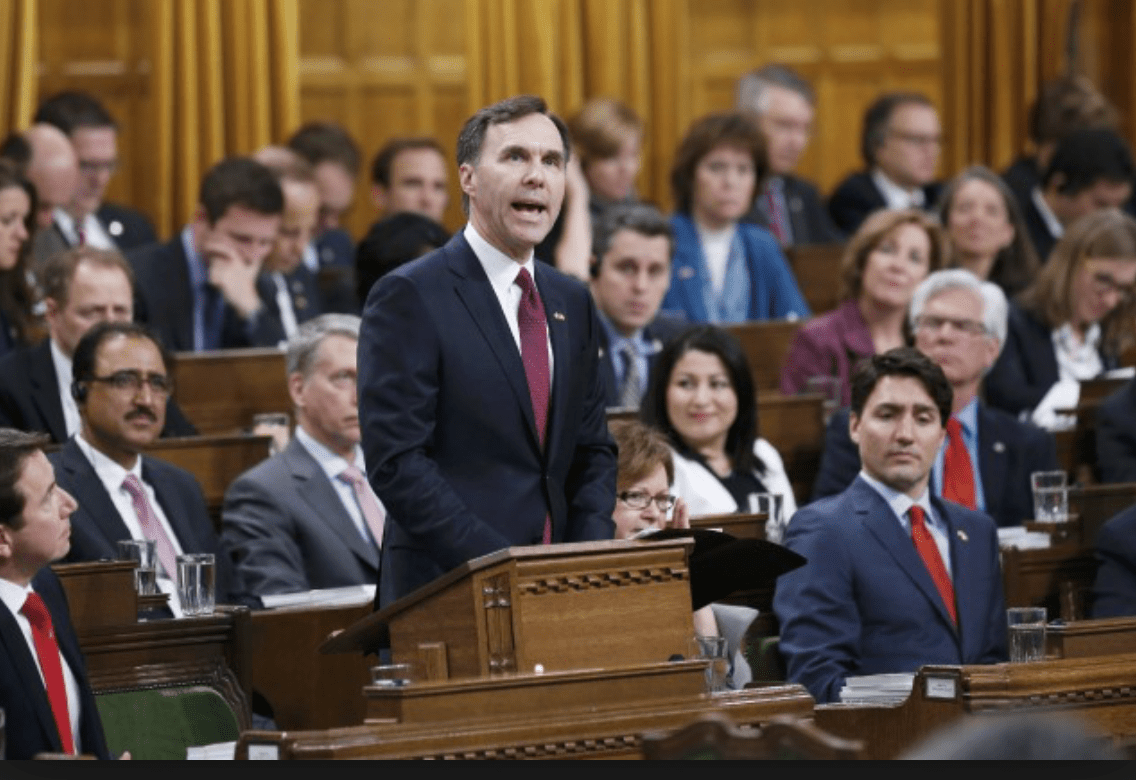By this time next week, it'll be budget day for the federal government, and one imagines a chance for the government to finally change the channel from the ongoing Double-Hyphen Affair and the interminable headlines associated with it. But with this in mind, we should also remember that we saw some fairly mixed economic signals in the past few weeks both unexpectedly soft GDP numbers, and unexpectedly strong job numbers that blew past even the job numbers coming out of the United States. What could this mean for the upcoming budget?
First of all, let's look back at the recent economic data. The Bank of Canada decided not to raise interest rates yet again, and to likely delay future hikes because the economy softened a little more than had been expected with the latest oil price crash. That crash, in part because the world price of oil remains depressed in relation to a global supply glut, and because the oil price differential that Western Canadian oil received on the US market spiked in large part because production increased at a time when major US refineries went on maintenance shut-down, creating a backlog in supply, had major reverberations in the economy. While the constrained pipeline capacity is a factor in this, we can't ignore that this was largely a supply and demand problem, which is why the price recovered so quickly after the announced production cut by the Alberta government. Most of those refineries are now back in operation, and the backlog is clearing, and the production cut is being eased faster than expected.
The other thing that the Bank of Canada noted was that household spending had slowed, in part because the housing market is shifting, and other consumption has started to decrease as Canadians are paying more attention to managing their household debt levels. That means fewer new cars being bought, and less spending on vacations and dinners out. But how does this relate to the federal budget? Let's think back to the last Conservative mandate, when they decided to reach a balanced budget at all costs while the economy was still recovering from the 2008 recession. The austerity budget meant that they were pushing economic stimulus into the realm of consumer spending, which was being fostered by the Bank of Canada keeping interest rates low so as to still have a stimulative effect on the economy. There was a push-pull dynamic as monetary policy was stimulative and fiscal policy was austerity, but consumers were able to rack up cheap debt. While the Liberals turned this around and put more fiscal stimulus into the economy, which did work and we saw new levels of growth and the lowest unemployment in forty years, the problem of the consumer debt has come home to roost, which is one reason why the Bank of Canada is so cautious in raising interest rates back up to a neutral range. (Remember that right now, interest rates are below inflation, so any savings accounts you may have are being slowly decimated).
With the economy softening again, does that mean that the Liberals should be turning the stimulus taps back up? Maybe, but maybe not. The Bank of Canada is still predicting the economy to start returning to stride again by the halfway point through the year, in part because the oil shock should have finished reverberating in the economy, but also because trade uncertainty from the NAFTA negotiations should be behind us, leading to greater investor confidence. There is already stimulus in the economy, between interest rates still being below the neutral range, and the government's infrastructure programme reaching its stride (given that it was largely back-loaded and they have had some difficulty in getting some of that money out the door because of the bilateral agreements with the provinces), and they have already indexed things like the Canada Child Benefit, which has also had a stimulative effect not to mention the fact that it has had a measurable effect in reducing poverty. This could all mean that the government doesn't need to do more stimulus, but just to keep on the same course and ride out this "detour," as the Bank's deputy governor Lynn Patterson referred to it.
We should also remember that there will be at least one big-ticket item in the window for the budget, which will be pharmacare. Dr. Eric Hoskins' committee is studying implementation not the concept itself, but how to go about it. That is significant, and while they did release an interim report last week, with the final report due later in the spring, I think that they have put some signals out there for the budget that the government can point to as part of their pitch to Canadians (and in the hopes that it will distract from the ongoing Double-Hyphen Affair coverage). This, along with some back-patting over reaching their poverty-reduction targets ahead of schedule, will help with some of their narratives about helping Canadians get ahead, which they'll want to base much of their re-election pitch on keeping the gains they've made in order to make more of them.
Of course, if the Conservatives remain true to form, we'll see much of the reaction about the budget based largely on the size of the deficit though the most recent Fiscal Monitor has shown that it's on track to be smaller than anticipated thanks to increased revenue (some of which may be from the retaliatory tariffs imposed on the US as a result of the ongoing steel and aluminium tariffs). That too may play into the upcoming election narrative a single-minded focus on the deficit number will lead to a debate over austerity versus economic growth, rather than one about whether the government's spending has been efficacious. I haven't been seeing any signals about a new round of "a chicken in every pot," but in an election year, it's certainly possible, and wouldn't be out of character for a government that has used up any increased fiscal room while keeping the focus on the debt-to-GDP ratio instead. It all may depend on how big of a distraction they think they need.
Photo Credit: La Presse






